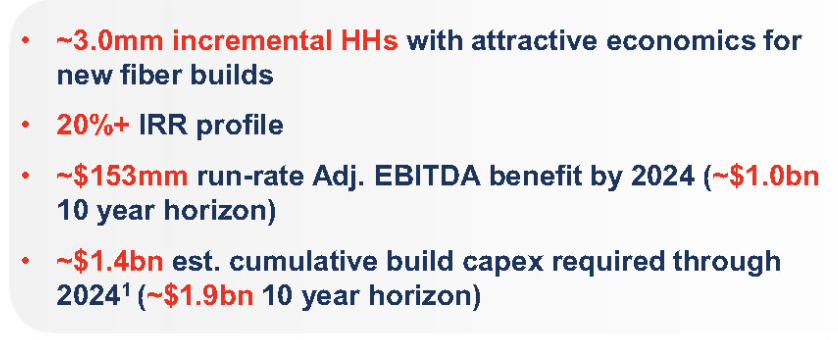Even before it announced that it would seek Chapter 11 bankruptcy, Frontier had a well-deserved reputation for mismanagement and abusive conduct. In an industry that routinely enrages its customers, Frontier was the literal poster-child for underinvestment and neglect, an industry leader in outages and poor quality of service, and the inventor of the industry's most outrageous and absurd billing practices. As Frontier’s bankruptcy has shown, there was no good reason they—and all old big Internet service providers—couldn’t provide blazing-fast fiber on par with services in South Korea and Japan.
Frontier's bankruptcy announcement forced the company to explain in great detail its finances, past investment decisions, and ultimately why it has refused to upgrade so many of its DSL connections to fiber to the home. This gives us a window into why ISPs like Frontier—large, dominant, with little-to-no competition—are choosing not to invest in better, faster, and more accessible Internet infrastructure. The reason American Internet lags so far behind South Korea, Japan, and Norway isn’t because fiber isn’t profitable. It just falls under the old adage “you have to spend money to make money,” an anathema to American ISPs’ entrenched position of prioritizing short-term profit over making lasting investments.
So long as major national ISPs continue to operate with that same short-term mindset, they will never deliver high-speed fiber to the home broadband of their own accord. If they will not do it, then policymakers need to be thinking about incentivizing others to do it.
Why Spend Money Now to Make Money Later When You’re Making Money Now?
Instead of being incentivized to grow a satisfied consumer base by investing in better service and expanding to underserved customers, publicly traded companies' incentives are dominated by quarterly reporting. They are driven to show larger profits every three months, and that short-term profitability woos big-dollar sources of investment and pleases the analysts whose judgments move the financial markets. This short-termism precludes investments that bear fruit in the future. That is why for years, the telecom sector has invested almost exclusively in programs that pay out in three to five years and neglected anything that pays out over 10 years or more.
This was why Verizon terminated its FiOS efforts more than a decade ago. When Verizon first started to deploy FiOS, and competing with cable companies such as Comcast and Charter, investment analysts criticized the company. They denounced the effort by a phone company to upgrade its old copper network to fiber as a waste of billions of dollars that would be countered by cable companies that could keep pace with early fiber speeds through a series of cheap, incremental upgrades to their coaxial lines. Verizon would have to invest $18 billion to cover just 14 percent of the country with fiber optic while cable companies across the entire country would match the early offerings of FiOS for less than $10 billion.
Investors denounced fiber investment as a waste because Verizon would have to spend many billions more on fiber to get the same results as the cable giants would get with cable lines. Of course, these dollars-to-dollars estimates missed the real point: fiber has the vastly superior maximum speeds, while cable tops out at a tiny fraction of fiber's possible speed. Even though the superiority of fiber is obvious today, the thinking of big ISPs has not changed.
That blinkered, short-term mindset doesn't just explain America's anemic fiber rollout, it also explains so much about Frontier's bankruptcy. Frontier has filed papers explaining how it intends to escape bankruptcy, and these conclusively show that millions of Americans currently stuck in the DSL Internet slow-lanes could be upgraded to blazing-fast fiber without a dime in government subsidies.
Frontier's own chart, below, shows the company's estimate of the profitability of its current fiber assets. Note that the company itself estimates that by 2031 the revenues from fiber would exceed costs and thus deliver increases in profit. Note also that for the first five years, the company would lose money on fiber. Fiber has high upfront costs (like a house), but it pays off handsomely over time. The inability to capitalize on superior investment opportunities because they take too long to mature is the very definition of dysfunctional short-termism.

Bankruptcy has forced Frontier to entertain these previously ignored long-term opportunities in its effort to restructure itself and return to business. In Frontier’s chart below, “CAGR Reinvestment” represents projections of increasing their spending into deploying fiber in 2021 with the pay-off coming in 2031. Untethered from the public market’s emphasis on constant profit, Frontier has concluded that investing more in more fiber for more people would generate more profits in 2031 and beyond.

How many fiber connections does Frontier now plan to upgrade in order to capture those long-neglected, long-term profits? Around 3,000,000 households dependent on legacy DSL could be upgraded to fiber to the home and deliver a 20 percent return on that investment by 2031. Frontier estimates that its IRR—aka its return on investment—would come in at around one billion dollars. Earning that cool billion in profit requires the company to invest about $1.9 billion in the communities it serves.

Frontier's historical calculus for deciding when, where, and how to invest excluded anything with less than a 20% return on investment. That's the kind of cherry-picking that bankrupt companies can't afford to engage in, and so now Frontier is eager to earn a 20% return on its infrastructure.
The fact that nearly three million homes could have been profitably served with fiber without government subsidy, yet were not been given fiber is a wake-up call. The only reason we are learning about this now is because Frontier is forced to tell us under bankruptcy law. Bankruptcy is also the only reason Frontier is considering doing it.
When You Have a Monopoly, Why Bother Improving?
The revelations from Frontier's bankruptcy filings don't end there. Equally important is how Frontier cultivated, maintained, and abused its monopolies. ISPs like Frontier know exactly where they have monopolies, and therefore know exactly who has no choice and therefore is not worth spending money on.
Frontier's documents reveal that the company treats its status as the monopoly provider of high-speed Internet access for 1.6 million households as a uniquely identifiable asset. Frontier wants investors to know that it can precisely demarcate its monopoly territories because it wants to show investors where it can get money (to repay its debt and get out of bankruptcy) by charging a captive audience more and delivering less.
The fact that Frontier—and its competitors—treat monopolies as a bankable asset would seem a sign that there should be some oversight. Since the FCC has removed its ability to oversee this industry since 2017 under the so-called Restoring Internet Freedom Order, that oversight will have to be from the states.

Internet access is an essential service that American households cannot reasonably forgo without inflicting real social and economic harms on themselves, even when the pandemic isn't raging outside their doors.
Clearly, ISPs know they can extract excessive profits from those households until an alternative arrives, which undoubtedly plays a role in Frontier’s and other big ISPs’ opposition to local governments building broadband alternatives for their community. Major ISPs are fond of touting America's supposed “competitive landscape” as a reason to dismantle net neutrality and ban community broadband, but the truth is they are dependent on unfettered monopolies in order to realize the rate of profit their short-term investors demand.
None of that is a secret, but the dots were never connected quite so explicitly as when Frontier just assured investors, in writing, that it was making a lot of money from more than one million people who have no feasible alternatives, and that this justified "investing" political dollars to block cities from building networks, even where there is no cable internet deployment. Frontier's bankruptcy documents reveal that these political investments were always viewed as cheaper than the network investments they would otherwise have to make to keep its customers once they were no longer held hostage to its ailing, crumbling, overpriced network.
This Is Standard Industry Practice, Frontier Is Not an Outlier
Giant monopoly ISPs have had decades to bring America's Internet into the 21st century. They have been singularly terrible at delivering decent speed, reliable service, reasonable customer support, or competitive prices. The only thing these companies have demonstrated competence in is making money for their investors. And Frontier's bankruptcy reveals that even that core competence is vastly overrate).
It's long past time we gave up on waiting for Big Telco to do its job. Instead, America should look to the entities with proven track-records for getting fiber to our curbs: small, private, competitive ISPs and local governments. These are the home of the "patient money" that doesn't mind ten-year payoffs for investments in fiber.
Fiber is vastly superior to every other means of delivering high-speed Internet to our homes, schools, institutions, and businesses. Nothing else even comes close (not 5G, either). For more, check out EFF’s own technical report on the relative speeds of different broadband technologies, and learn why we want state governments to guarantee universal, affordable, competitive fiber to the home networks. That's why we actively support legislation in California to have the state finance a universal open-access fiber infrastructure built by smaller entities.
Policymakers shouldn't assume that the dirty laundry Frontier just aired in its bankruptcy is unique to that one company. Frontier's problem wasn't that it couldn't run a broadband service – it was it couldn't sustain the short-termism that Verizon adopted when it ditched FiOS and that AT&T adopted when it killed its own fiber buildout the second its legal obligations to deliver fiber expired. Frontier's biggest mistake was buying rural legacy networks from AT&T and Verizon, which allowed those companies to offload their neglected networks onto Frontier’s lap.
Frontier's bankruptcy is the inevitable consequence of long-term network neglect caused by an emphasis on short term profits.
AT&T and Verizon should be deploying fiber everywhere to compete with cable everywhere. They're not, and they're still profitable on paper, but only because they can paper over their steadily eroded customer numbers because they are making profits through their wireless divisions and their content subsidiaries
But when tiny 6,000 person rural cooperatives are deploying fiber to the home but your local town is still stuck with slow DSL from a big telephone company, it is not because the company can’t make money investing in your community, it is because they have chosen not to, and then lobbied to make it illegal for anyone else to do it.











